To me, most grilled rib recipes found online seem to be mostly the same: St. Louis-style ribs or baby back ribs recipe cooked low and slow (or hot and fast) and then slathered in store-bought barbecue sauce.
This style of ribs is totally acceptable, but it gets sort of tired after a while. They’re certainly a step up from the ribs I grew up eating that were, shall we say, less than stellar.
You may have read in my other blogs about my dad boiling St. Louis-style ribs to a slow and painful flavor death before dunking them in barbecue sauce and burning them to a crisp on the grill—not great, to put it mildly.
You may ask yourself, how do I prepare pork ribs that are both easy to make and delicious?
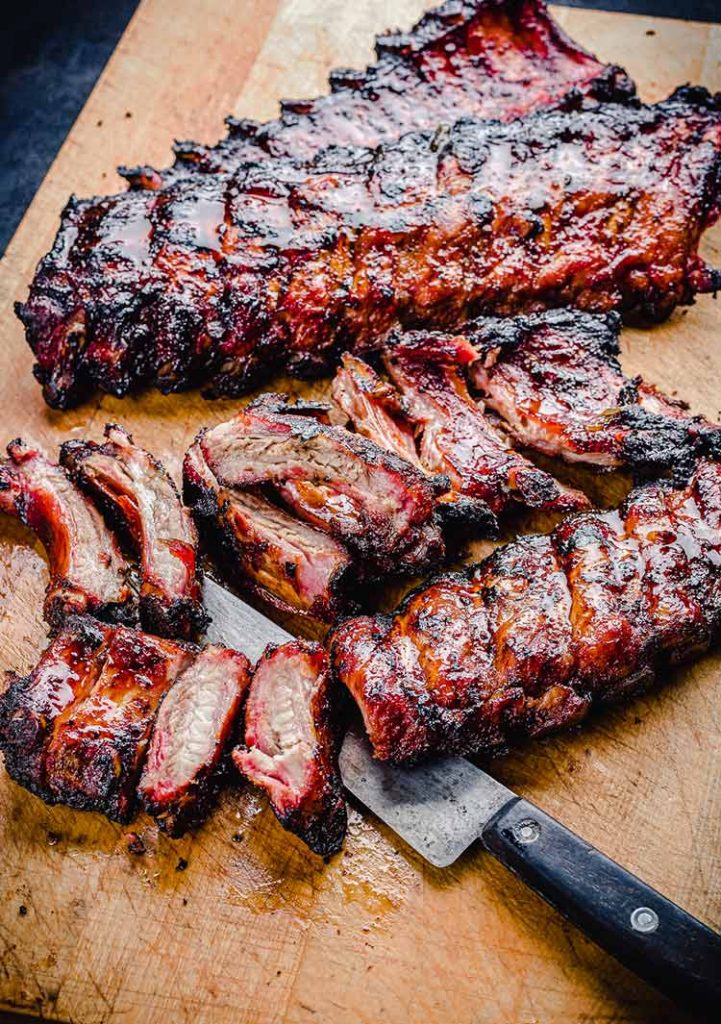
The answer is simple: Make a brine for pork ribs. It’s definitely something fun and different. Follow this easy rib brine recipe and say hello to your new best friend.
I developed this brine for pork ribs that’s not only easy to make but will give you consistently juicy and delicious results every time.
One of the great things about this brine is that it works as well for St. Louis-cut ribs (spare ribs) as it does for baby back ribs, pork loin, pork chops, etc.
Anyway, I digress. This blog is about brining ribs. If you want to learn more about ribs, my blog about the difference between spare ribs and baby back ribs outlines the differences.
Over the years, I have experimented with many different flavor profiles. This recipe is a favorite of mine and perfect for something slightly different than the typical BBQ rib.
Today, I am using a barrel-style cooker, but you can use any grill or smoker. Just be sure to use indirect heat. I’ve done these plenty of times on a Kamado-style grill, a kettle grill, and an offset cooker.
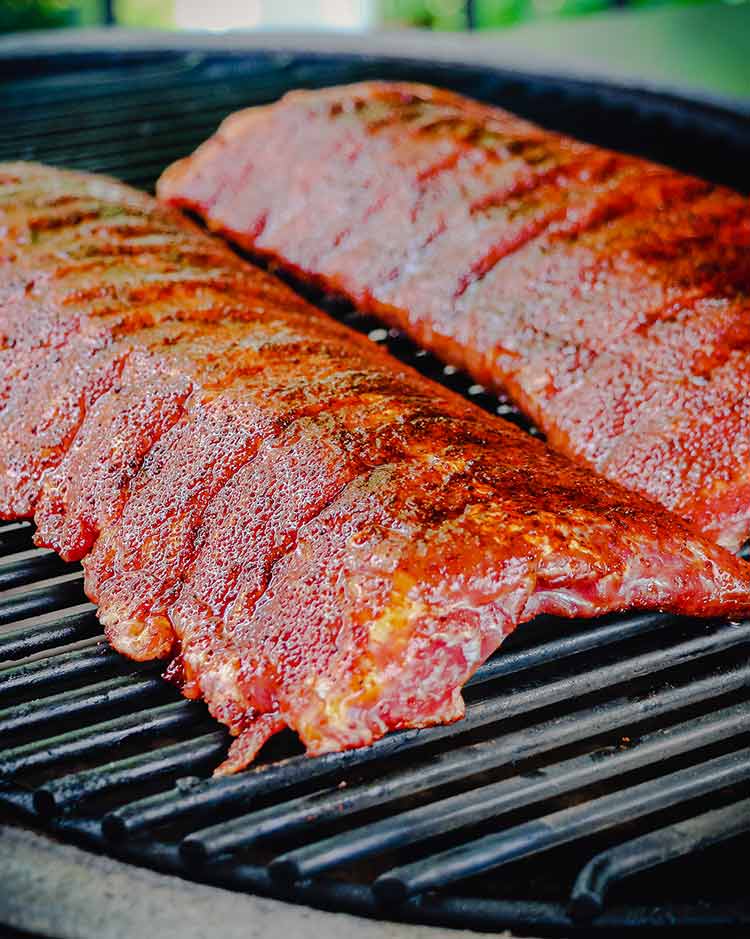
Many people ask me, at what temperature are ribs done? I wrote this blog about how you know your ribs are done as a general guideline.
For me, baby back ribs’ internal temperature should range between 193 °F and 203 °F when read with a reliable quick-read thermometer. This is a matter of personal preference.
A lower temperature will have meat more firmly attached to the bone. This allows for a bite-through texture on a rib.
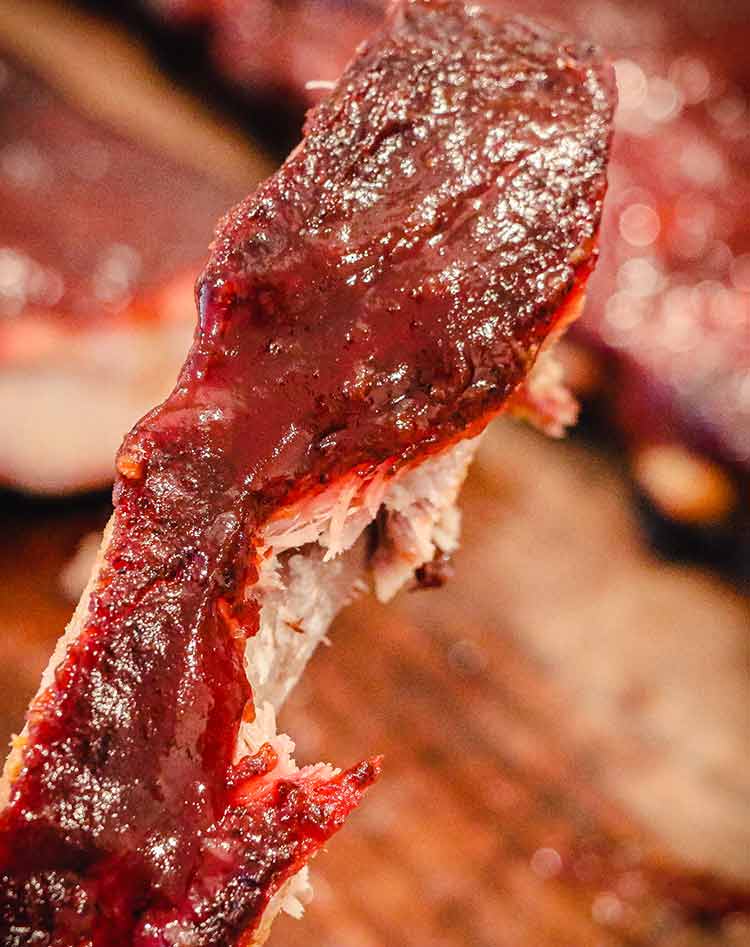
But as the internal temperature increases, collagen—which helps keep the meat attached to the bone—melts and the rib meat becomes softer and much easier to bite through.
Typically, rib meat cooked to an internal temperature between 200-203 °F will be almost falling off the bone and you’ll spend less time flossing your teeth after dinner.
Just keep in mind that cooking times may differ slightly with each style of cooker. Slight temperature variation can change the cooking time dramatically.
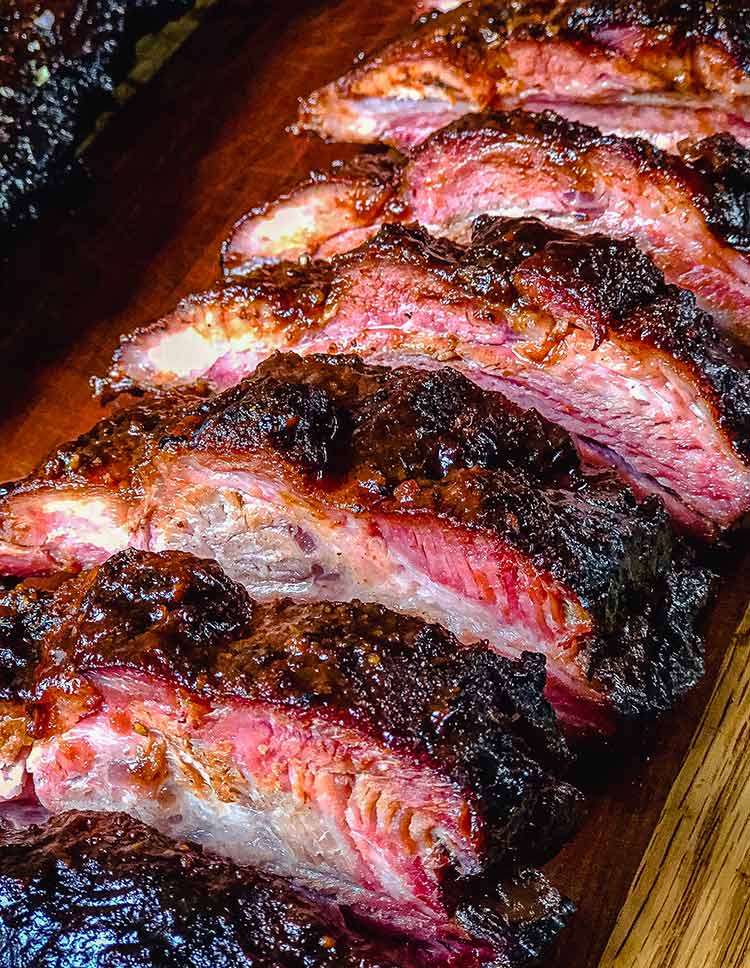
Apple Cinnamon Brined Baby Back Ribs
Serves: 6 | Prep time: 25 hours (inactive) | Cook time: 3.5 hours
Ingredients:
2-3 racks of baby back ribs
Brine:
6 cups water
3 cups apple cider or apple juice
1 cup white sugar
⅓ cup kosher salt
6 cinnamon sticks
2 tbsp black peppercorns
1 tbsp whole cloves
2 bay leaves
Rub:
½ cup light brown sugar
⅓ cup paprika
1 tbsp kosher salt
1 tbsp garlic powder
1 tbsp onion powder
2 tsp ground cinnamon
2 tsp chili powder
2 tsp black pepper
1 tsp dry mustard
How to Make Apple Cinnamon Brined Baby Back Ribs
Step 1: Combine water and apple cider in a large pot and bring to a rolling boil, then add remaining brine ingredients.
TIP: If you don’t have apple cider, apple juice will work as well.
Cover the brine and let boil for 10 minutes. Remove the brine from heat and allow it to cool to room temperature. Pour one cup of brine into a spray bottle.
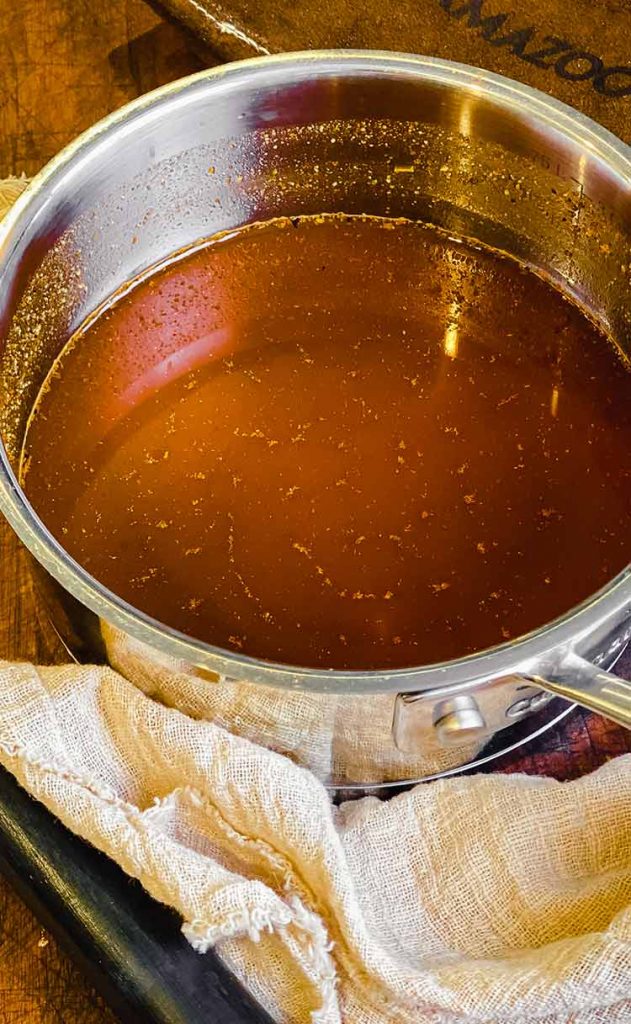
Step 2: Remove the membrane from the backside of the ribs. Think of this membrane as an impenetrable flavor barrier.
Neither your rub nor your brine can get through this membrane, so removing it will make all the difference in the world to your finished ribs.
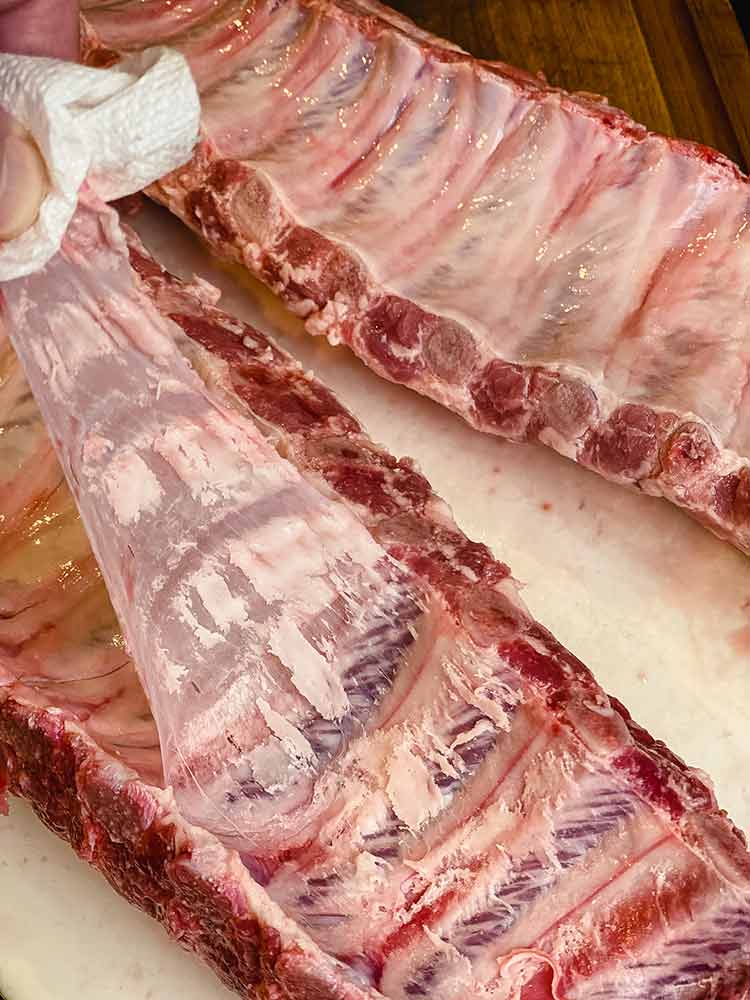
Step 3: Submerge ribs into the room-temperature brine, making sure they are completely covered. I find it’s easiest to use a cheap disposable aluminum chafing pan for this, but use what you have.
Step 4: Place ribs in the refrigerator for 24 hours.
Step 5: While the ribs are brining, combine rub ingredients and put into a shaker bottle—set aside.
You can make more of this if you like, I use this rub on other things as well; the cinnamon brings a unique flavor to various meats.
TIP: If the brown sugar is clumping together, use a fork to break it up.
Step 6: Light your grill and set up for two-zone cooking, establishing temperature at 285–300 °F.
Step 7: Remove ribs from the brine and discard brine. Pat the ribs dry with a paper towel.
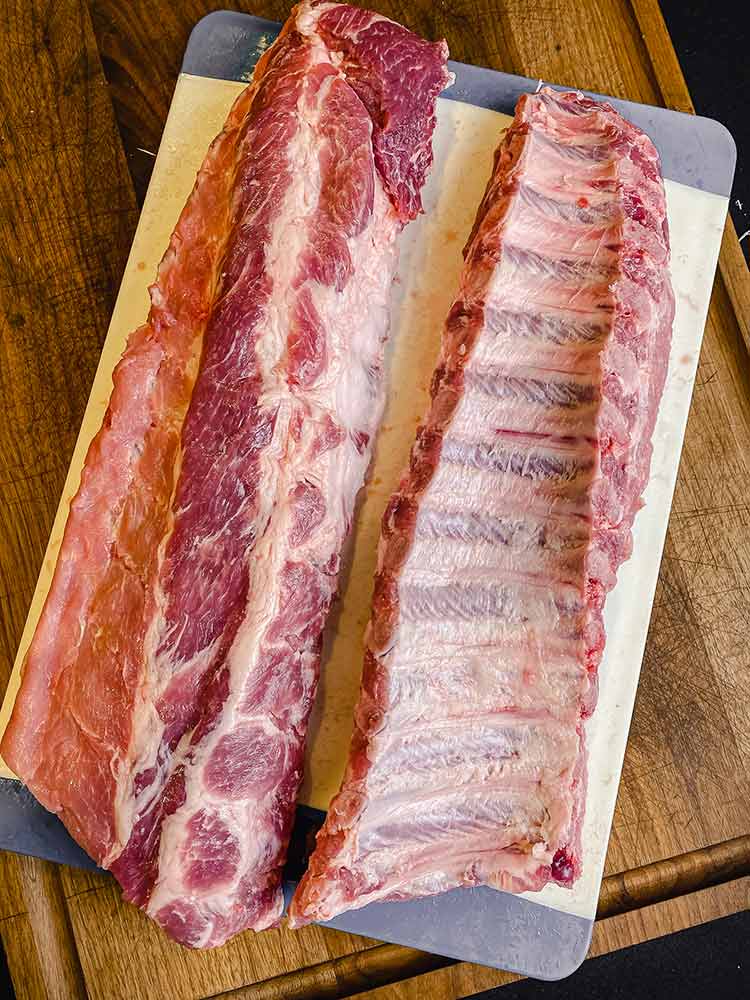
Step 8: Rub a very thin coat of vegetable oil onto the ribs. This will act as a binder for the rub.
Step 9: Sprinkle the rub generously onto the racks of ribs. Ensure you cover the front, back, and sides of each rack.
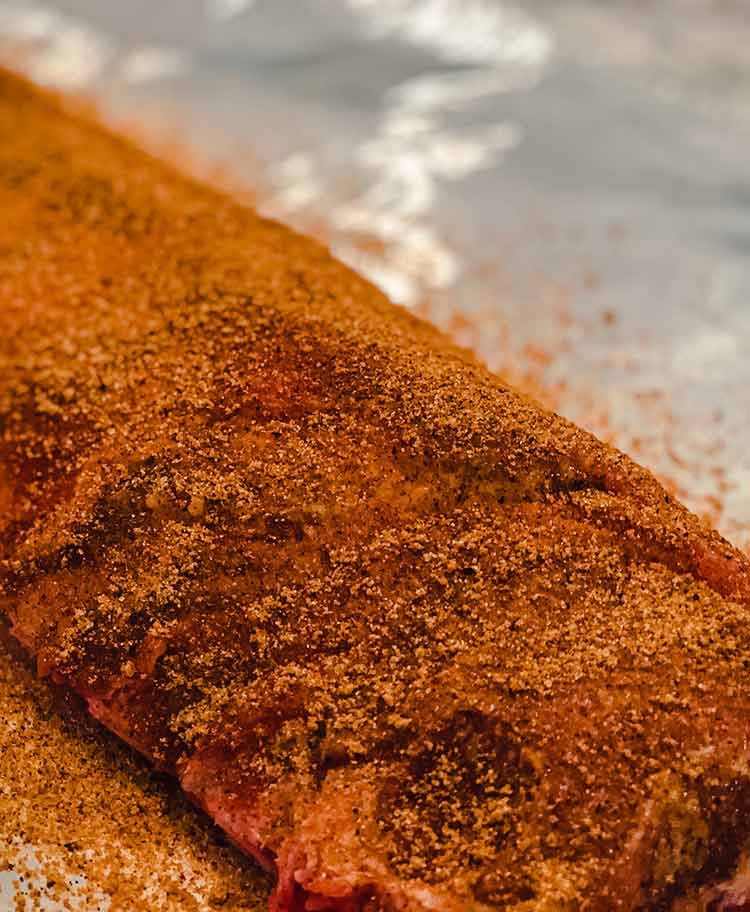
Step 10: Place the racks on a cutting board and gather your meat hooks. I like to use two hooks when I am hanging ribs. You can get away with one, but two just keeps things more secure.
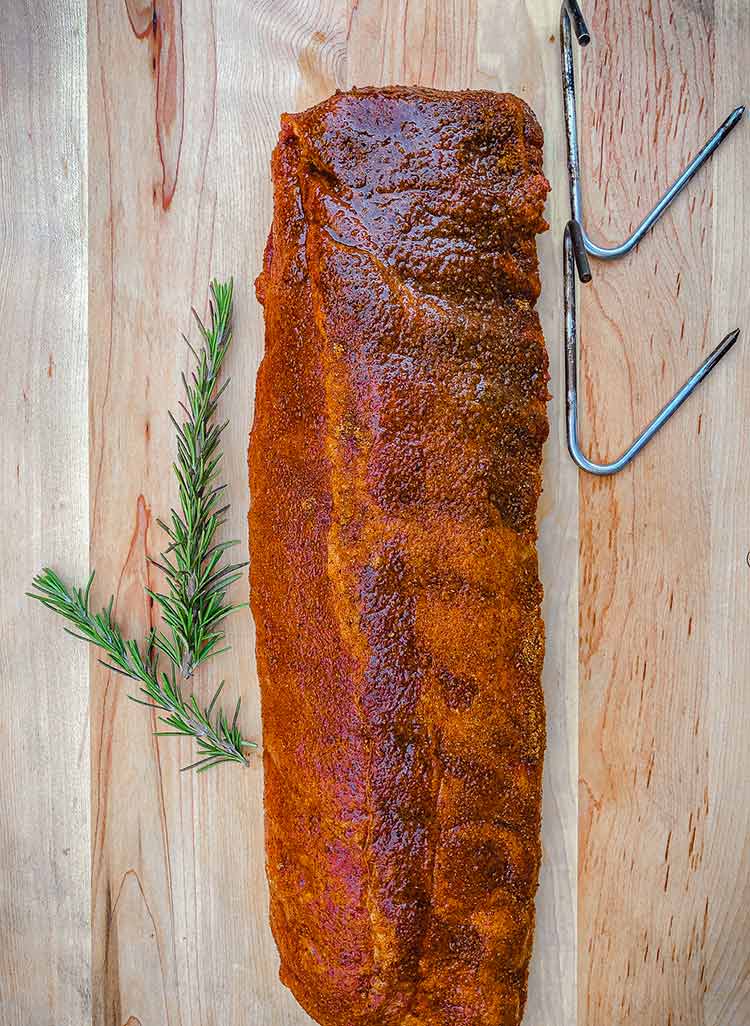
Step 11: Place the first meat hook onto the rack of ribs. I usually go about two bones deep on the first hook.
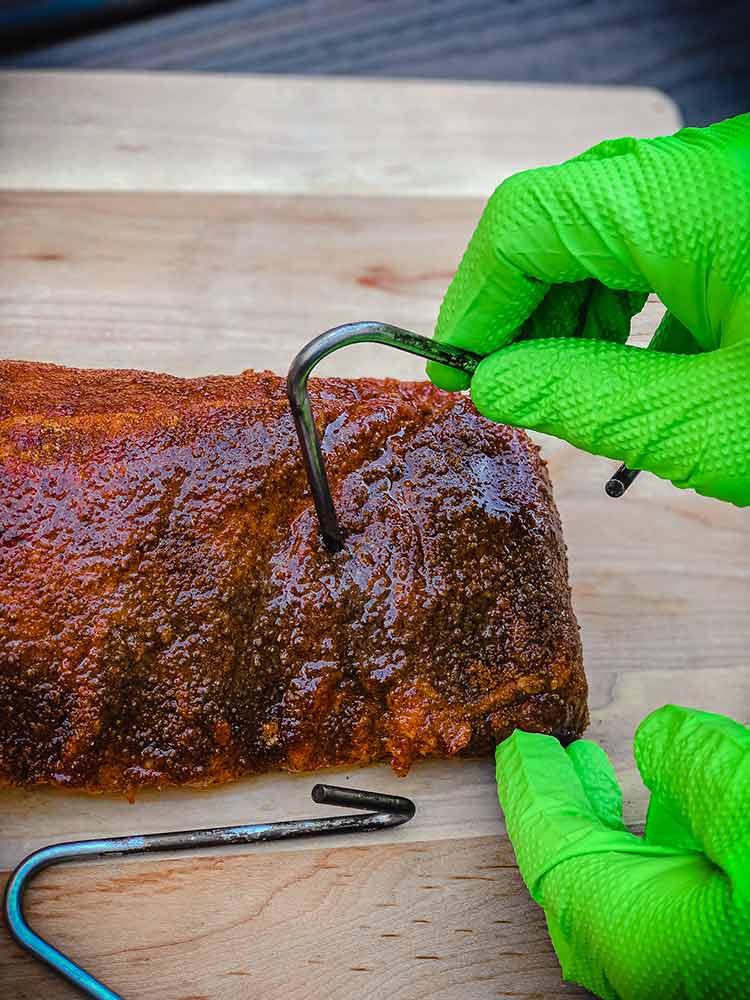
Push the hook all the way through the meat, and ensure it lays flat against the ribs.
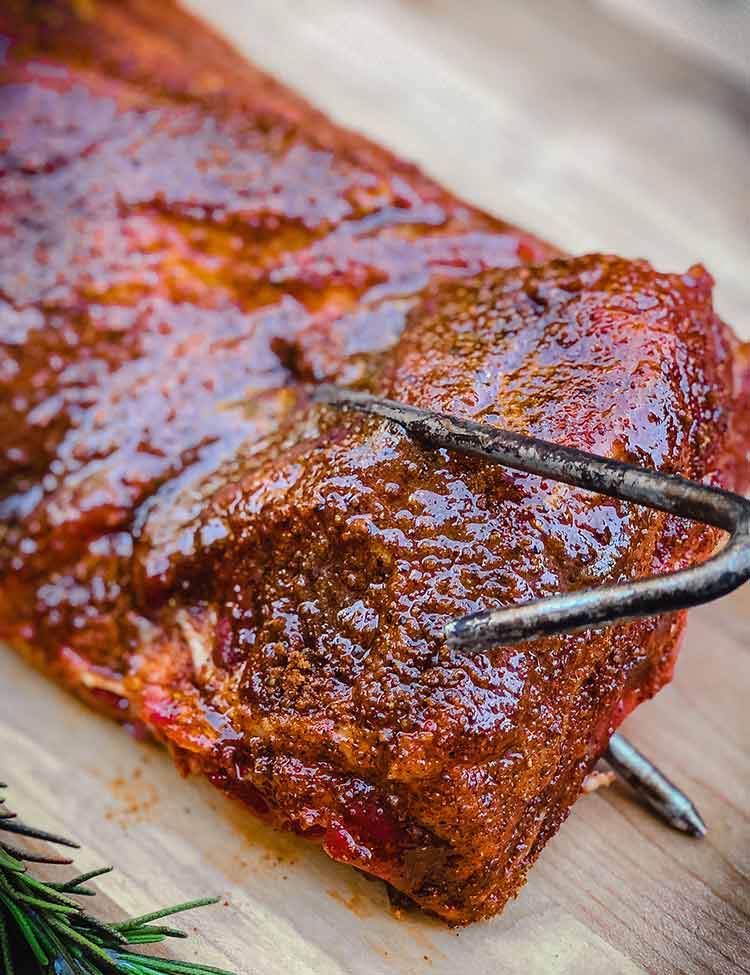
Step 12: Note where the curvature of the first hook is when placing the second hook.
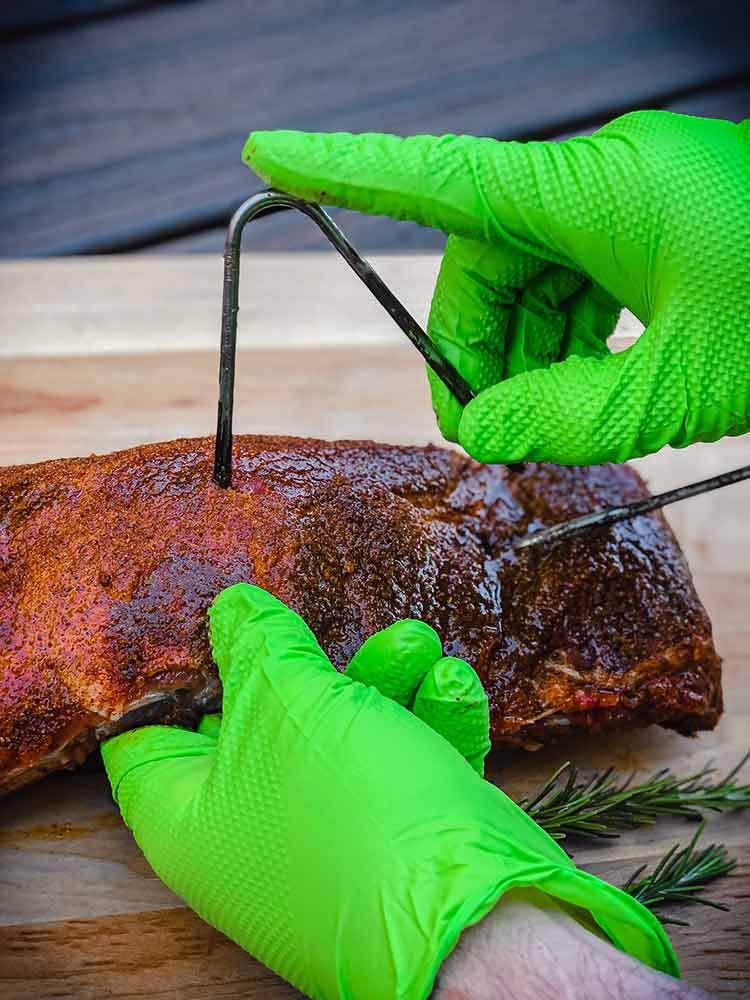
I have cooked ribs with a single hook but I just feel better about the extra support.
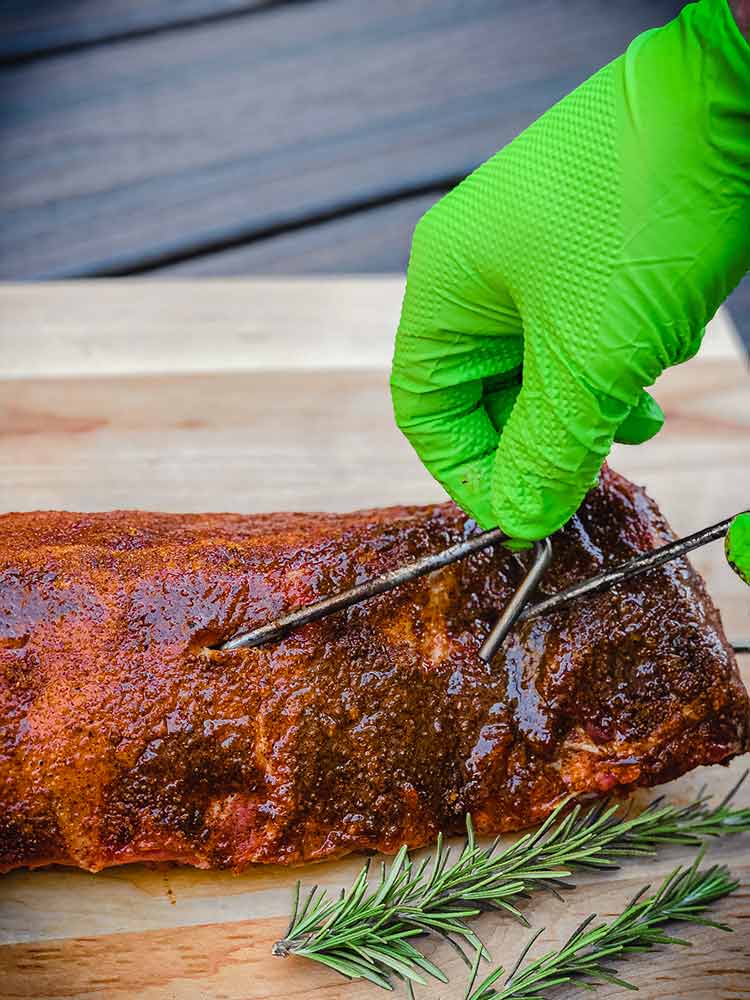
After inserting the second hook, connect it to the first hook for extra support and peace of mind.
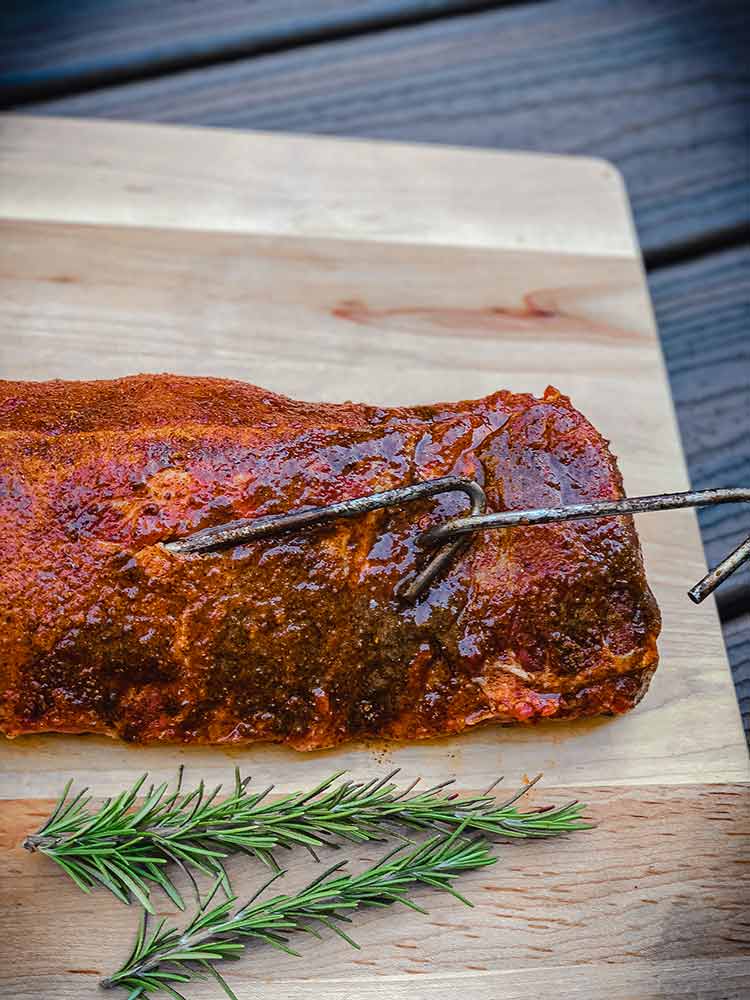
Step 13: Add apple wood chunks to hot coals and hang the ribs inside the barrel. Cook for about 3 hours, spritzing with the brine every 45 – 60 minutes.
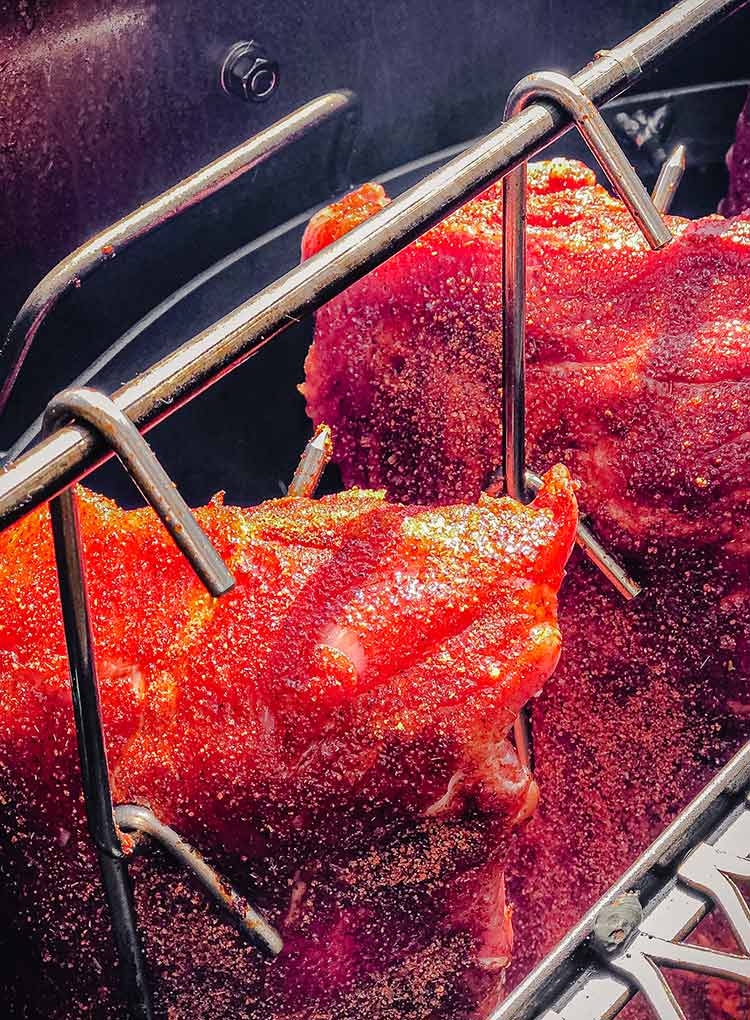
If you’re using a Kamado-style grill or kettle grill, just ensure you place the ribs over indirect heat.
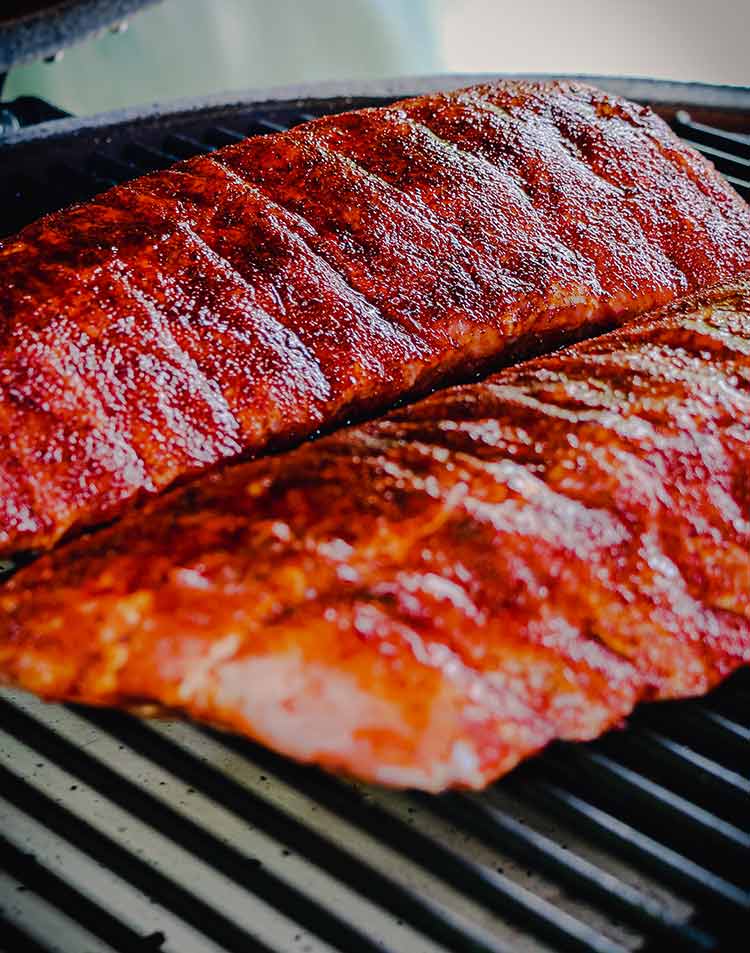
Step 14: Remove the ribs from cooker using a hook. Do not grab the hooks with bare hands! Allow to rest for about 10 minutes uncovered before slicing and serving.
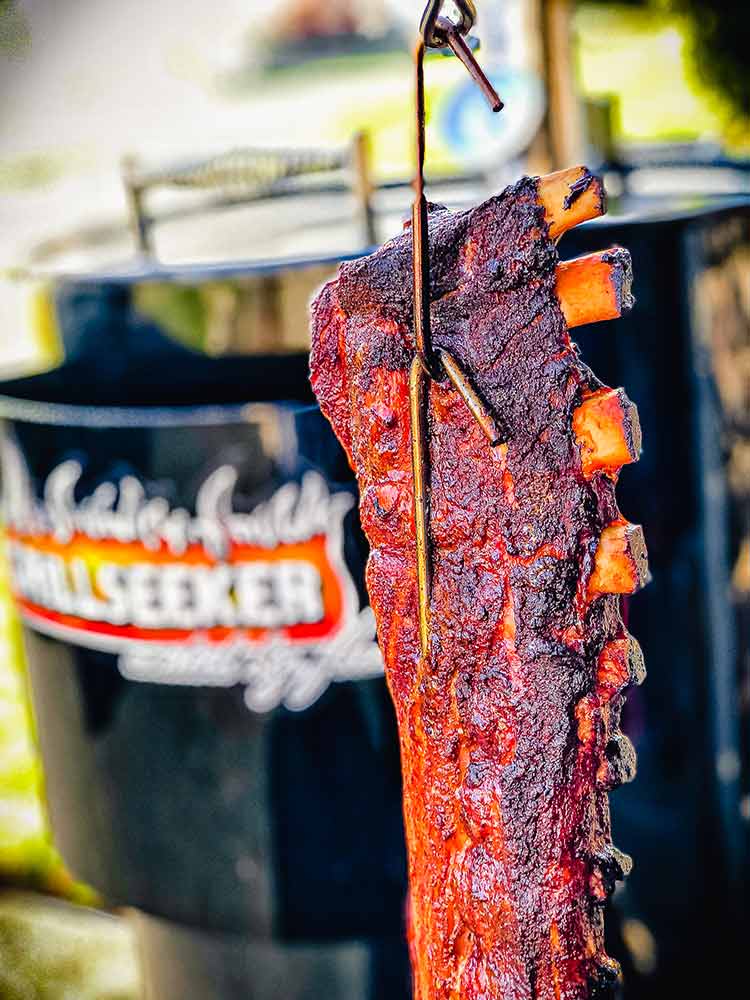
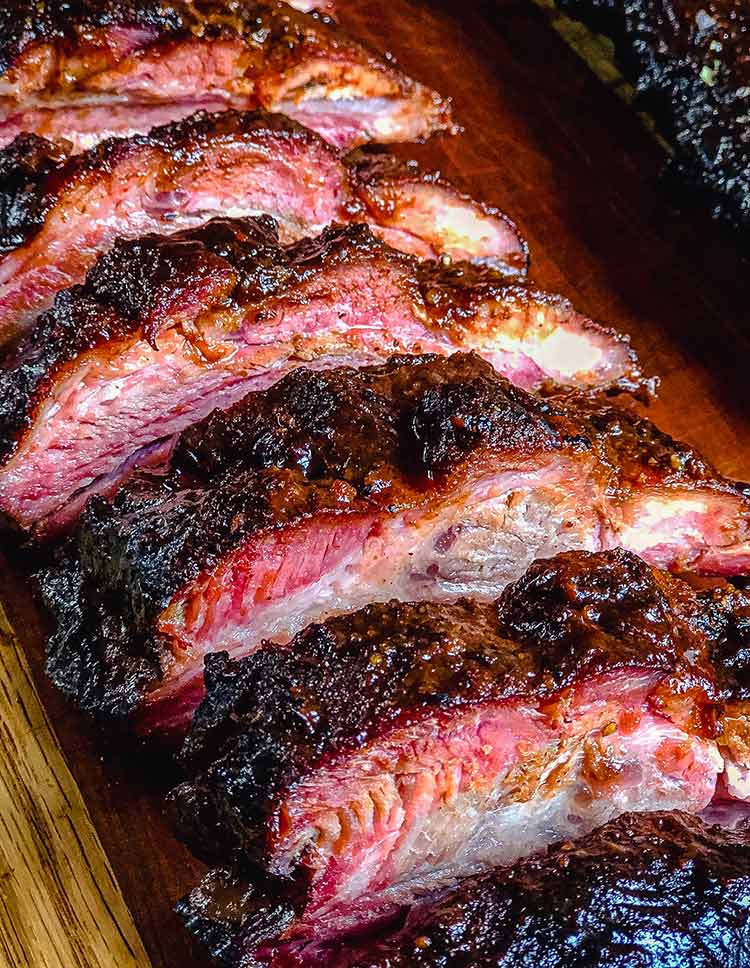
Ingredients
- 3 racks baby back ribs
Brine
- 6 cups water
- 3 cups apple cider or apple juice
- 2 cups white sugar
- ⅓ cup kosher salt
- 6 sticks cinnamon
- 2 tbsp black peppercorns
- 1 tbsp whole cloves
- 2 bay leaves
Rub
- ½ cup brown sugar
- ⅓ cup paprika
- 1 tbsp kosher salt
- 1 tbsp garlic powder
- 1 tbsp onion powder
- 2 tsp ground cinnamon
- 2 tsp chili powder
- 2 tsp black pepper
- 1 tsp dry mustard
Instructions
- Combine water and apple cider in a large pot and bring to a rolling boil, then add remaining brine ingredients. If you don't have apple cider, apple juice will also work.Cover the brine and let boil for 10 minutes. Remove the brine from heat and allow it to cool to room temperature. Pour one cup of brine into a spray bottle.
- Remove the membrane from the backside of the ribs. Think of this membrane as an impenetrable flavor barrier. Neither your rub nor your brine can get through this membrane, so removing it will make all the difference in the world to your finished ribs.
- Submerge ribs into the room-temperature brine, making sure they are completely covered. I find it’s easiest to use a cheap disposable aluminum chafing pan for this, but use what you have.
- Place ribs in the refrigerator for 24 hours.
- While the ribs are brining, combine rub ingredients and put into a shaker bottle—set aside. You can make more of this if you like, I use this rub on other things as well; the cinnamon brings a unique flavor to various meats.
- Light your grill and set up for two-zone cooking, establishing temperature at 285–300 °F.
- Rub a very thin coat of vegetable oil onto the ribs. This will act as a binder for the rub.
- Sprinkle the rub generously onto the racks of ribs. Ensure you cover the front, back, and sides of each rack.
- Place the racks on a cutting board and gather your meat hooks. I like to use two hooks when I am hanging ribs. You can get away with one, but two just keeps things more secure.
- Place the first meat hook onto the rack of ribs. I usually go about two bones deep on the first hook.Push the hook all the way through the meat, and ensure it lays flat against the ribs.
- Note where the curvature of the first hook is when placing the second hook. I have cooked ribs with a single hook but I just feel better about the extra support. After inserting the second hook, connect it to the first hook for extra support and peace of mind.
- Add apple wood chunks to hot coals and hang the ribs inside the barrel. Cook for about 3 hours, spritzing with the brine every 45 – 60 minutes. If you’re using a Kamado- style grill or kettle grill, just ensure you place the ribs over indirect heat.
- Remove the ribs from cooker using a hook. Do not grab the hooks with bare hands! Allow to rest for about 10 minutes uncovered before slicing and serving.


I’m enjoying just reading about them ! I’m trying this brine today, hubby smoking tomorrow, I’ll be back to tell how yummy I’m certain this will be ! Thanks in advance
Excellent Margerry, please let me know how you liked them. They are some of my FAVS!
Just curious of the point of the spray bottle of brine?
Hey Matthew, Thanks for checking it out. I use the saved brine in a spray bottle to spritz the ribs while they are on the cooker. I spritz them about every hour. Hope this is helpful!
-M
That is what you use on step 12 to spritz the ribs every 45-60 minutes
Why did my ribs turn grey after brining ?
Hi Amanda, thanks for checking this out. The brine has some acidity to it because of the apple juice. The acidity will cause the color to change to a sort of grayish hue. It’s pretty normal. I hope you loved them!
-M
This incredible recipe is worth posting a review. These are absolutely delicious!!! My guests raved about them and some said they were the best ribs they’ve ever had. Note: I don’t have all the fancy equipment and I just cooked mine on a basic grill and they still turned out perfect! Recommend!
Thank you for the kind words Ali – so happy you and your guests liked them. No fancy equipment required!
-M
This recipe looks amazing and I have my 2 racks ready to go. I just have 1 question? Would the ribs still turn out good if I cooked them in a crockpot? Unfortunately I don’t own a grill.
Hi Pauline – I don’t know that I would do them in a crockpot, but you could definitely do them in an oven. Good luck!
-M
I’ve brined chickens and turkeys and thought I would look up to see if there was a recipe for brined pork ribs for something different we just finished eating these ribs and holy crap they are amazing. It’s our new go to recipe for ribs. Good job.
That’s awesome Philip, so glad you enjoyed them!
-M
Are there any changes to the recipe or cooking method if doing St. Louis ( spare ) ribs? Also, if not using hooks but laying the ribs on the cool side of the grill rack?
No changes at all for different types of pork ribs. And yes, if not using hooks for hanging the ribs, just ensure the ribs are placed on the grill or smoker over indirect heat.
-M
This is the first time I’ve ever left a review. These were incredible! I was rushed on time, so had to cook on slightly higher heat on my green egg, but they were amazing. Thinking that I want to try the recipe on wings as well. Both the brine and the rub should work great!
Excellent Eric, please let me know how the wings turn out! Thats a brilliant idea!
-M
Have t tried this yet but reviews look great. After brining I plan to sous vide ribs as they are so tender after 36 hrs in sous vide, then a quick trip on grill. Can’t wait
I made these this weekend. They are truly amazing. The recipe for the brine and the rub are spot on with flavors. Adding to my family recipe book.
I can’t wait to do a venison neck roast using this recipe.
That’s so nice to hear, let me know how the venison turns out!
-M
I received so many compliments on my ribs using this recipe that it is now my go to recipe for BBQ. The only change I think I’ll make will be cutting back a bit of the salt and adding a little more heat (spice).
Thank you so much, I’m glad you love them!
-M
This recipe is a concoction of wonderful. My wife absolutely does not like ribs but this recipe right here has changed her mind. I have shared this recipe with friends and all of them gave great praise. Thanks for sharing.
Thanks for trying it out Frank!
-M
Hi, Can I use this recipe and cook in an oven? If so, what temperature and for how long. Thank you!
Hi Yvonne, you can definitely use the oven for these, though you wont get any of the smoke you would if you were using a pit. That said, I’ve made some amazing ribs in the oven in a pinch! I would go with 275°F for about 3 hours in the oven, then check for tenderness. You might have to wrap them in aluminum foil for an extra 30 minutes or so to get them as tender as you like. I hope this helps!
-M
Hi!
Do I have to wrap them in foil before placing on the grill??
Thanks, Ty
Thanks for the question Ty, that’s personal choice. I never wrap when using a barrel cooker, but generally wrap when doing low and slow on a traditional style grill.
-M